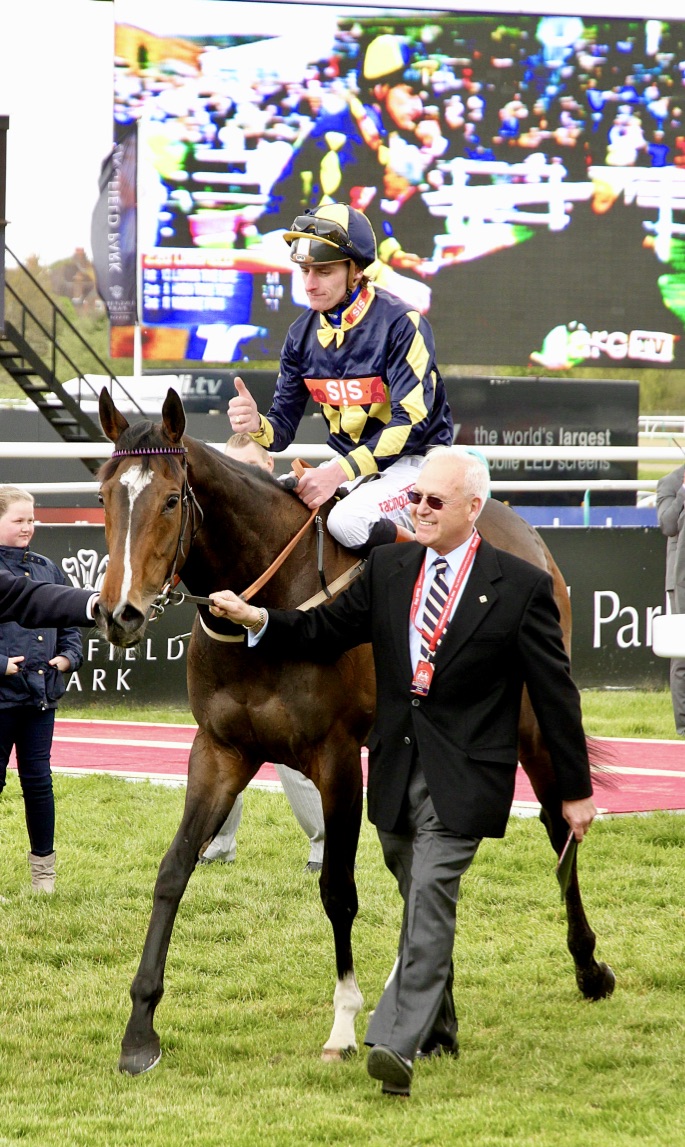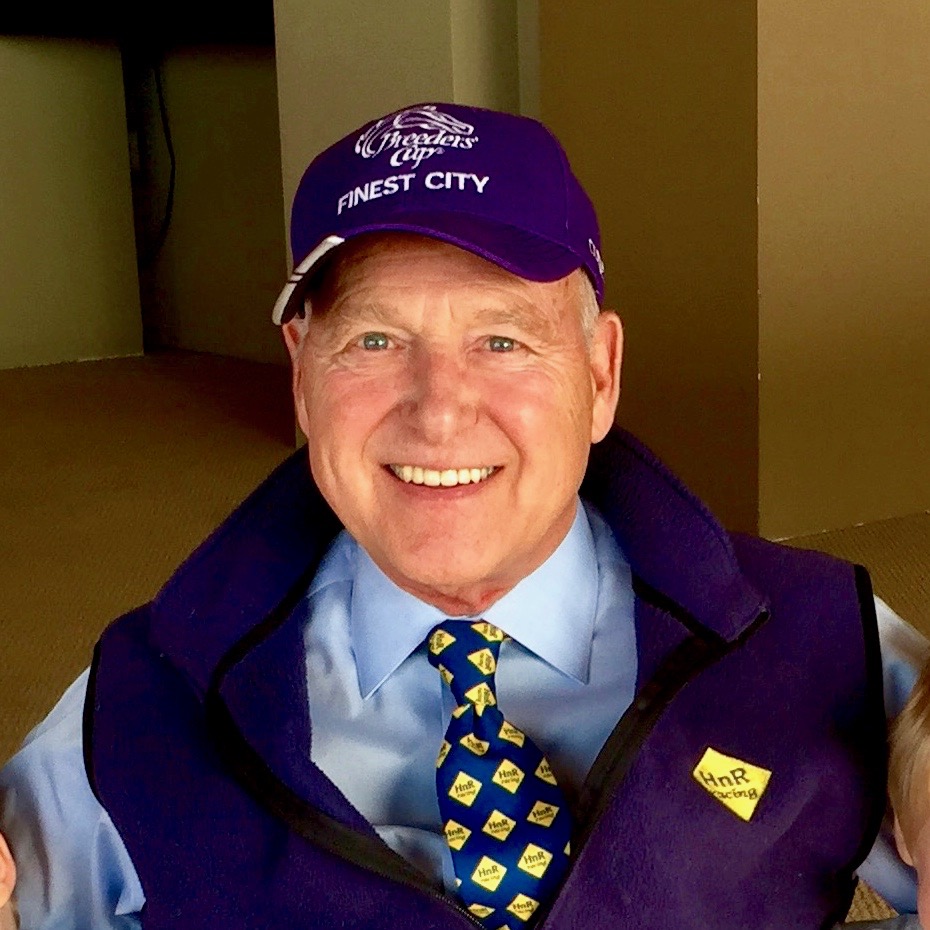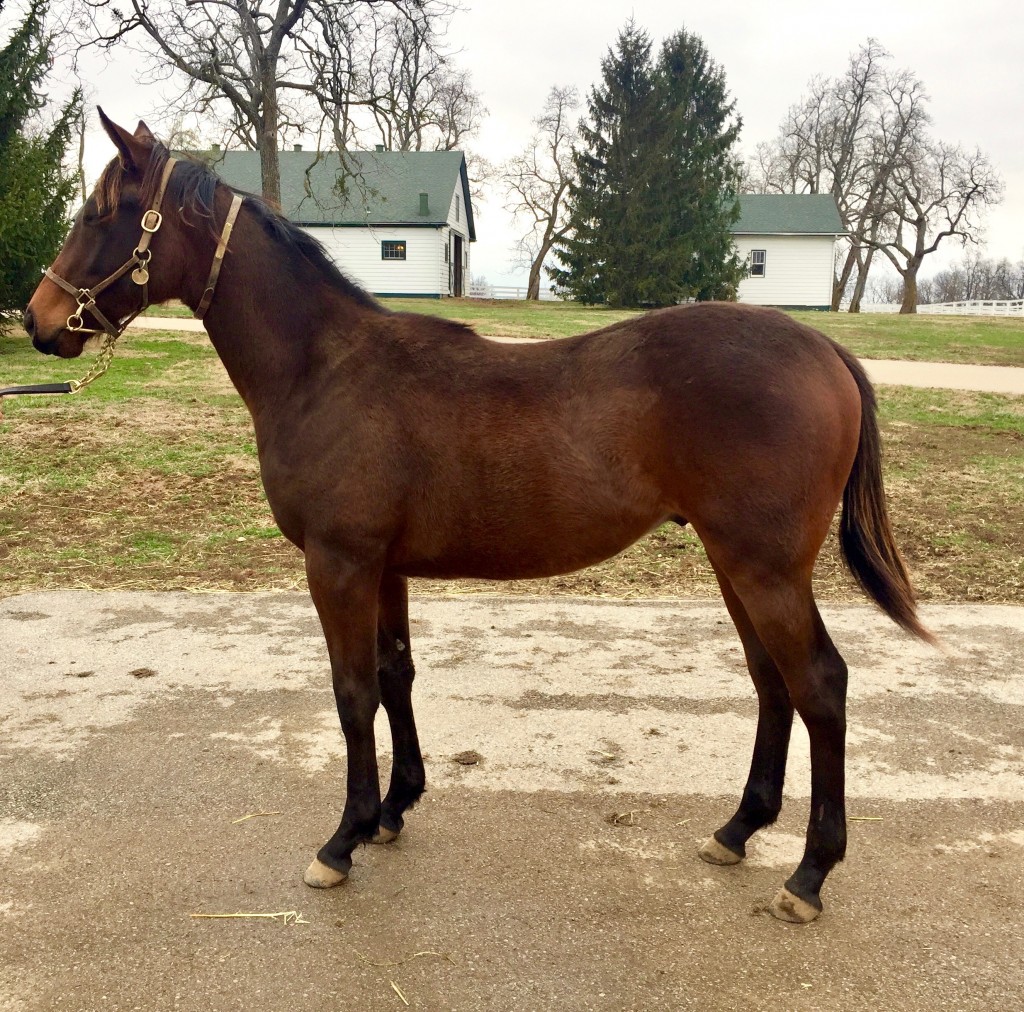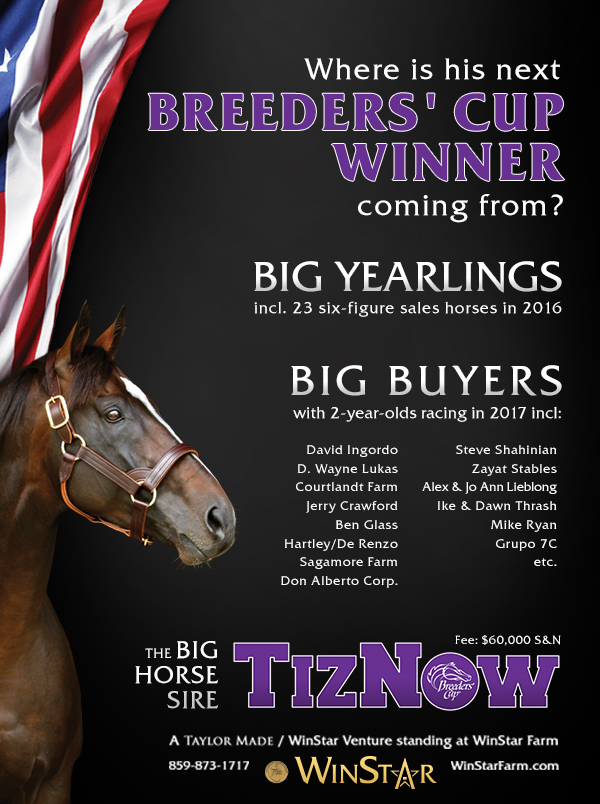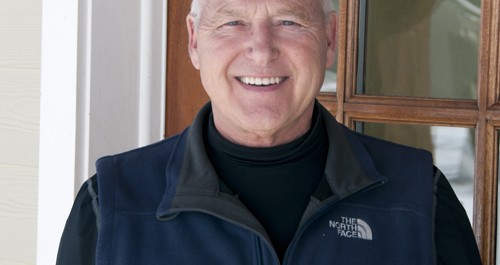Tag: Pioneer of the Nile
Nothhaft finds thrills in the Thoroughbred Industry
INTERVIEW Bloodhorse Daily “MarketWatch”
Sept 28, 2018
By Meredith Daugherty
twitter @BH_MDaugherty
Ten years ago, Hank Nothhaft founded HnR Nothhaft
Horse Racing and dove into the world of
Thoroughbred breeding, racing, and sales. Blood-
Horse MarketWatch spoke with Nothhaft about what
sales mean for his operation, how the state of the market
affects breeders, and what the industry can do to
help ensure continued success at all levels.
MarketWatch: How did you get your start in the
industry?
Hank Nothhaft: After graduating from the (U.S.)
Naval Academy and serving in the Marine Corps, I
became a startup technology executive. I ended up
as the CEO of five venture-backed, high-tech-based
startups in the telecommunications business. It’s a
high growth environment; I call it adrenaline-driven.
Looking over the horizon and going from being
the young bull to the old bull, I realized that even if
I wanted to go on forever, I had to be realistic. So I
systematically decided to start a business that would be
a viable alternative to being a CEO that I could run in
retirement and have a lot of fun with. To have the same
sort of thrills I experienced in the business world. So
in 2007-08, I stuck my toe in the water of the industry
and have proceeded from there via the school of hard
knocks, trying not to make the same mistake twice.
We’ve had a lot of tumult in a short period of time
because of the significant financial recession that
occurred in 2008. I got started just before that, and
I had made some calculations that turned out to be
not very accurate, but because I was a financial expert
when the collapse occurred, I took advantage of that
situation to do what I call a “restart round” and push
aside the things I had done incorrectly to try and have
a more successful path. I certainly had the satisfaction
of enough good things happening that my adrenaline
addiction has been satisfied.
MW: Were you familiar with the industry at all
when you made your transition?
HN: I had no direct connection with the horse
racing industry whatsoever when I started, but I get up
most mornings very thankful that I made that fateful
decision to get involved. My wife and I were very casual
fans, so that was certainly part of it. The other part was, I
went to Europe frequently and I was addicted to reading
Dick Francis novels, and I would carve a day out here or
there to go to tracks within easy rail distance from London.
I had a romanticized view of the British horse racing
industry, but as silly as that sounds, it
did play a part in my decision.

The American Pharoah colt consigned as Hip 91 at the
Keeneland September Yearling Sale
MW: Ten years after forming HnR NothhaftRacing, how did you feel
about watching the American Pharoah—Kindle colt that you sold
as a weanling for $400,000 sell for $2.2 million as Hip 91 at this year’s
Keeneland September Yearling Sale.
HN: It was a great time. I derive a lot of satisfaction from those
moments, and it doesn’t have to be a big monetary achievement. I think
the sale was fantastic. I think it was like a Hollywood script that we had
the first yearlings from a Triple Crown winner, and we
had Sheikh Mohammed there for the first time in 10
years. We also had the Coolmore/Godolphin détente in
place and a phenomenal stock market going, a new tax
bill, new players in the industry, a global marketplace …
what could be better than that? The results of the sale
are unequivocally outstanding.
MW: What was special about that colt that you
remember from your time with him?
HN: I paid $50,000 for his dam, Kindle. I had a
tremendous relationship with the horse, spent a lot of
time with her when she was racing, and she was our
first stakes winner. She has the greatest disposition.
The reason I was able to buy her was that she was a
bit short. I moved her to Kentucky because regional
sires are not really commercial, but I breed all my
Pennsylvania mares in Kentucky, and they’re all foaled
out in Pennsylvania.
With Kindle, and a handful of really commercial
mares, I’ve been producing Kentucky-breds, but
mostly I have Pennsylvania-breds. No one knew with
her what kind of foal she’d produce, but she’s a robust
mare. With American Pharoah, I was lucky to have a
couple mares that were good enough to be accepted, so
I bred Kindle to him. From the get-go, she produced
an exceptional foal. Almost perfect. He’s the proudest looking,
most balanced horse, and I love the streak of
lightning blaze on his face. He was the prime candidate
to sell as a weanling. My reserve was $400,000, and it was exactly on
the nose.
I’m so excited for the horse, because I’ve heard rumors that they’ll
ship him to the United Kingdom. Assuming that’s the case, the top
folks in the Sheikh’s operation will get a good look at him and then
put him in a position somewhere in the world to be as successful as
possible. My great hope would be that he works out as a dirt horse and
that maybe he could be the Sheikh’s Kentucky Derby (G1) horse.
The one thing I realized by selling horses is that they
end up in better hands than mine. People with better
contacts, more money, and better resources than my
own. There couldn’t be anyone that meets that criteria
better than Sheikh Mohammed. When you sell them,
you set in motion a chain of events that could never
have occurred had you retained ownership yourself.
I bred Kindle to Pioneer of the Nile, and I have this
phenomenal Pioneer of the Nile colt. He’ll be in Book
1 of the Keeneland November Breeding Stock Sale.
I also had Hip 1 in the (September) sale. She was an
RNA, so I have entered her in the Fasig-Tipton October
Yearling Sale (as Hip 624). I want to try to capitalize
on the current market demand for quality American
Pharoah bloodstock. I am confident that given a better
position, she will be a standout in this sale. If not, we
are certainly prepared to keep and race her, as she is a lovely filly.
“When you sell them you set in motion a chain of
events that could never have occurred had you
retained ownership yourself.”
—HANK NOTHHAFT
MW: From a breeder’s perspective, what did you
think about the Keeneland September sale and the
quality of the yearlings being offered?
HN: In terms of the sale’s success being a mark
of our industry turning the corner from the market
downturn, the thing that I really look at as a breeder
is, how many horses are being bred? The last numbers
that were available are not super encouraging. We kind
of flattened out more or less three or four years ago,
and we haven’t really turned the corner. Kentucky has
gotten back to where they were 20 years ago, but if
you look at what percentage of horses that represents,
they’ve gone from being 35% of the horses bred in the
industry to somewhere around 55%. That means, likely,
if you look at each state, all the other states have had
significant declines.
I look at those bigger states that have had a tradition
in the horse racing business, and some of them are
at a third of where they were, some have all but
disappeared. So coming out of the sale, I think the thing
is that the industry will have really turned when the
horse population responds or we reduce the amount of
racing that is taking place, because there aren’t enough
horses to feed the engine we currently have.
I think you have to look at the sales and look at the
later books and see how many horses are being sold at
a loss. You have to ask yourself, “Why and how could
this sustain itself if there are people who are breeding
and losing money?” And they can’t continue to do that
indefinitely. I think one of the bright spots can be state
incentive programs like in Pennsylvania, where I’m
involved. You can breed a reasonably competitive horse
there, keep it, race it, and make money and have fun,
or take it to a sale and maybe it sells at a loss, but if
the owners race it, then you can actually break even or
make a profit.
What’s kept me happy and in the game is that I’m
treating this like a startup. I’ve been bootstrapping and
reinvesting what I have back into the business to grow
it, and one of the big things that has helped me do that
is the state incentive program. Relative to my needs,
it’s generated a lot of cash that’s helped keep me in
the game. I can tell you without breeders, there is no
industry. Period.
If the industry wants to maintain the broad racing
schedule they have, they’re going to have to inevitably
produce more horses. Eventually, it has to be profitable,
or at least help people break even, for breeders and
enthusiasts to get into the game. I do know a lot of
people took mares out of service in smaller states, so we
need those to come back in.
MW: Do you think the market can continue the
trajectory it has taken this year?
HN: There are hard-core, central players in the
Thoroughbred industry, and those non-newcomers
are not that affected by the stock market and non discretionary
income. They are to a certain extent, but I
think the U.S. economy is in a sweet spot, and the only
thing that could upset the apple cart in my mind would
be the federal reserve increasing interest rates too
fast and somehow cutting off this really perfect scenario
we’re seeing in the economy.
My view right now is that we’re solid in the U.S.
I think other countries will adopt more pro-growth
strategies (for) their economies, and that will provide
even more underpinning to the industry. The other
side of the coin, however, is that with breeders, some
other countries have the same problem I proposed that
we have. I think they’re thinking, for example in the
U.K., of putting together a type of incentive program.
Hopefully, breeding numbers start reflecting that
programs are working here in the states.
The top end and the middle market are much higher
than they were. People have got to bid higher for horses
than they would have had to previously. I think what is
true is that people had to bid more money because you
have more money chasing the same number of horses.
The thrill of owning a horse and being involved in the
industry is fantastic. If people were more exposed to it,
many people would want to do it. BH
Kindle 16 Tiznow colt now named Made in America (KY)
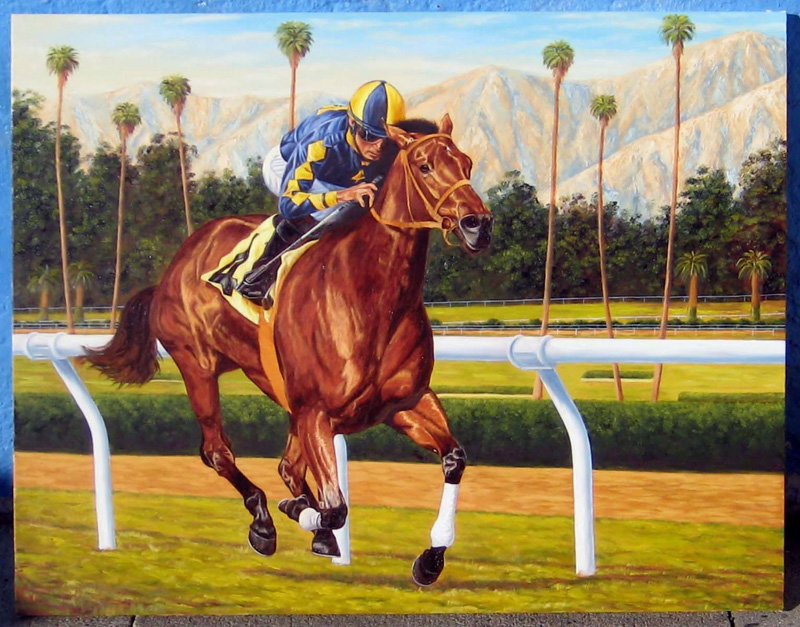
Kindle a MSW/MGSP mare by Indian Charlie o/o Carson’s Vanity by Carson City had her first foal on January 26, 2016 @Darby Dan Farm in Lexington, KY. Kindle is short in stature, very muscular and always gave 100% during her racing career for HnR Nothhaft Horseracing. She ran a career best Beyer Number of 100 winning the Cool Air Stakes. Our high level goal in breeding to Tiznow was to get a horse with a combination of Tiznow size, durability and stamina with Kindle speed and muscularity. Ideally this foal would grow into a miler plus with exceptional tactical speed. We are a long ways off from knowing whether our objectives will be achieved, but so far we like what we see.
Made in America (KY) by Tiznow o/o Kindle @Darby Dan Farm
We have decided to keep Kindle 16 to race. As a result, we have named him Made in America (KY). As a January yearling, he stands nearly 15 hands which makes him almost as tall as Kindle. He weighs around 980 pounds which makes him large for his age. His conformation is excellent and he is well balanced and a nice frame to grow into. We are counting the days until we can move to the next step and start Made in America’s initial training.
The other days we are counting are the days until Kindle has her second foal. She is in foal to American Pharoah with a colt expected in the next two weeks or so. We are hoping this foal will have the same excellent confirmation that Made in America enjoys. If he does, we will likely put this colt up for sale in one of the weanling auctions at the end of the year.
Finally, to give Kindle every chance to succeed as a broodmare, we are breeding her to Pioneer of the Nile at Winstar for the 2018 foal. Time will tell how this story will evolve, but we are excited to be part of the journey. We are hoping he could be Tiznow’s next Big Horse.
Planning for Success-Businessman Nothhaft Breeds a winner with Pennsylvania Breeding Program
Henry R “Hank” Nothhaft Photo Anne Litz Mid-Atlantic Thoroughbred
This Article Originally appeared in the June 2014 Issue of Mid-Atlantic Thoroughbred
It appears here in its’ entirety with Mid-Atlantic Thoroughbred’s permission.
This article authored by Cindy Deubler
Click on Photos for larger image and captions. Supplemental videos added to this article.
Henry R “Hank” Nothhaft knows business. Studying spreadsheets, business plans and bottom lines is second nature to the Pennsylvania native who resides in California and made a career of taking hightech start-up companies in California’s Silicon Valley and nurturing them into multi-million-dollar businesses. Nothhaft applies his business acumen to Thoroughbred racing and breeding and has his plans in place. Locking onto the Pennsylvania breeding program, the affable and energetic CEO has leaped in with both feet, building a broodmare band he boards at Northview PA in Peach Bottom, investing in stallions, and creating a racing stable on both coasts. And he’s enjoying every minute of it.
“As a lifelong entrepreneur I knew I’d be bored out of my mind when I retired, so I thought ‘I’m going to have to start a business to run before retirement occurs,’ ” said Nothhaft, 70, during one of his trips to Pennsylvania over the winter to visit his growing broodmare band. “So I did an analytical approach. . . the competition, the data-driven aspects, the massive amounts of bloodlines. It had always appealed to me – it’s very competitive, instant feedback, outsourcing model, no employees, and so on. I put together a bunch of factors and I chose horse racing and breeding.”
Nothhaft (pronounced note-off) was born and raised in western Pennsylvania, near the Ohio border, and had no previous background with horses. His earliest introduction to live racing came at the Standardbred tracks near Columbus, Ohio,as a teenager. It was a fun diversion. Nothhaft went the military route early in his career – he graduated from the Naval Academy in Annapolis, Md., and was a Marine captain who served in Vietnam – and followed that with graduate school, which led to his introduction to the technology world, which led to sales for high-tech companies in the 1970s. “That’s very close to being an entrepreneur,” said Nothhaft, who is quick to admit that he always wants to succeed in anything he tries to do. “Next thing you know, I wanted to be more than the guy selling the stuff, I wanted to be more involved in the company and running it.”
Nothhaft’s passion for the American dream is boundless. The loss of business in recent decades in the Silicon Valley prompted him to write the highly acclaimed book Great Again, which came out in 2011 and explores solutions to return the United States to prominence as an innovation leader in the world. More than ready to speak out about the political climate in Pennsylvania and its adverse effect on the breeding industry when discussions come up about taking away incentives.

Photo Anne Litz Mid-Atlantic Thoroughbred
“People who are serious about making significant investments in any industry, including Thoroughbreds, like to have a long-term horizon. And some predictability,” said Nothhaft. “So if the landscape is negative, you can take that into effect and decide whether you want to be in that business. If you have a positive environment and positive incentives, which Pennsylvania certainly has, but you think they are fleeting and may be taken away at any time, it’s very hard to make multimillion-dollar long-term investments in the industry.”
Nothhaft slips easily into using corporate-world terms when describing his Thoroughbred operation. “The goal is to breed to race and sell and get quality to the point where it becomes self-sustaining or grows from the reinvestment of the profit.” He owns approximately a dozen broodmares, has a stable in California with trainer Gary Mandella and another string at Parx Racing with trainer Keith Nations, who had been based in California. “My commitment to Pennsylvania racing is bolstered by Nations’ move to Parx as my exclusive [East Coast] trainer,” he said. As with any business plan, adjustments are often necessary. Nothhaft initially started purchasing horses in California in 2006, but when the financial market experienced its setback in 2008, he sold off all his California assets (although he still has one broodmare in production in the state) and decided to relocate to Pennsylvania because of the strength of the state-bred program. Nothhaft had already done a lot of homework. “In 2006 I started scratching the surface of studying pedigrees,” he recalled. “I wrote a business plan. This was part of that analysis I did. I went to a couple of seminars that the Thoroughbred Owners of California ran, learning the ins and outs of horse racing, what all the rules were, tax implications and record keeping, breeding. Then I plugged into The Blood-Horse [magazine]. I bought all the books in their library, from breeding theories totaking care of mares. Even though I don’t run a farm, I read all those books and watched all their videos on how to evaluate horse flesh.
“I spent a lot of time self-educating, and then I started meeting people in the business through these seminars and asking a lot of questions. I’ll be quite honest – some of the people I got involved with initially, I made poor choices. They weren’t terrible people, they just weren’t effective and not the right people for me. It’s good I got started to breed to race in California and we had the massive setback. It hit me in the face.”

Photo Hank Nothhaft Jr.
One solid connection Nothhaft made in California was Mandella, his trainer since 2010. Purchasing yearlings for Nothhaft under the HnR Nothhaft Horse Racing banner, Mandella and bloodstock agent Mary Knight selected the Indian Charlie filly Kindle at the Keeneland September Yearling sale in 2009 for the novice owner,
spending $50,000.

Benoit Photo
Kindle has overcome numerous setbacksto win or place in nine of 11 starts, take two stakes and hit the board in four graded races. She even pushed two-time Breeders’ Cup Turf Sprint-G1 champion Mizdirection in last year’s Grade 2 Monrovia Stakes at Santa Anita, losing by a half-length. Destined for Nothhaft’s broodmare band, the 6-year-old once again went to the sidelines in January following a solid second in the 2014 Monrovia, her first start in nearly a year. Back in training, she is being prepared for the Royal Northern Stakes at Woodbine in late July. Should all go well, a trip to Parx for the Grade 3 Turf Monster in September is on the agenda before returning to California.
Video
Kindle Duels Mizdirection in 2013 Monrovia Stakes
Another significant accomplishment for Nothhaft came through his association with bloodstock advisor Carl McEntee, formerly with Ghost Ridge Farm and Northview PA before leaving for Darby Dan in Kentucky. The two met in the fall of 2010, and McEntee has advised Nothhaft on purchases of broodmares and European-based fillies at the track. Among the broodmares was Sulis, a young winning daughter of Maria’s Mon who cost Nothhaft $105,000 at the 2012 Keeneland November sale while carrying her first foal. Three months later, Sulis delivered a filly by Harlan’s Holiday at Northview PA. In November, the filly was in the sales ring at Keeneland, selling for $250,000, the top price for a Pennsylvania bred weanling last year.

Photo Henry R “Hank” Nothhaft
Video
Sulis 13 Harlan’s Holiday Keeneland Sale
“Carl has an uncanny eye and a willingness to have a discipline in bidding for horses when buying mares, yearlings or whatever,” said Nothhaft. “We set very specific goals and budgets. . . I go to all the auctions now that I’m retired – even beforeI was retired I went to most of them. Carl and I will sit there and agree on a price before we walk into the room. We haven’t chased the horses – we’ve passed on hundreds But because of our good planning and discipline, we ended up buying a horse like Sulis. A fantastic buy.
“Our goal has always been to buy the mare in foal, and have the first foal cover the purchase. And so far, other than a couple I kept myself that we could have sold for that, we’ve accomplished that.” Another rising star found by McEntee is the 4-year-old filly Living The Life (Ire), a daughter of Two Thousand Guineas-G1 winner Footstepsinthesand out of a Machiavellian mare. Purchased in February in England for $60,000 and transferred to the Newmarket training yard of McEntee’s brother Phil, Living The Life has since
won twice in four starts over the all-weather track at Lingfield.

Photo Becky McEntee
Her final start before shipping to California came in the $252,000 All-Weather Championship Fillies and Mares Condition Stakes April18, which she won easily. She will be pointed to the Del Mar meet this summer. “Part of my plan is to buy pedigreed fillies in the U.K. for value prices equal to their U.S. residual value and then try to step them up by succeeding on the track in the U.S.,” said Nothhaft. Two other fillies following that path are Macaabra (Ire), a 4-year-old daughter of the hot international sire Exceed And Excel out of a Sadler’s Wells mare, and the Irish-bred Halljoy (by Halling), Group 3 placed in England last year at 2. Macaabra joined the Mandella barn in 2013, and won an allowance race at Santa Anita this year. Halljoy shipped to the U.S. with Living The Life and is awaiting her first start in the HnR Nothhaft Horse Racing colors.

Photo Ian Headington
Videos
Living the Life Wins All Weather Championship 2014
All Weather Championship Post Race Interview
Those silks have special meaning to Nothhaft – they are Navy blue and gold. “I have the same relationship with the Naval Academy as I have with horses, I love it,” he said. And while Nothhaft’s wife Randie and sons Hank and Ryan and their families enjoy the horses and going to the track onthe West Coast, he said it “has turned into more of a business for them because it’s isolated from them.” But Nothhaft can’t help naming horses for family members. One of his most prized broodmares, somewhat to his wife’s chagrin, is Randie’s Legend. Nothhaft laughed when he said, “My wife said I could continue in horse racing as long as I
didn’t name another horse after her.”Another was named First Blue Angel (in honor of his father-in-law Capt. Roy Marlin “Butch” Voris, who founded the Navy’s Blue Angels flight demonstration squadron). And when he had two grandsons born a month apart this past year, Nothhaft named a California-bred yearling using their first names, Sawyer and Jett. “When Sawyer’s Jett goes to the track, we’re all going to go. I had named her something else, but when we had the two babies, I wanted to name a horse after them that they could see.” Nothhaft supports numerous stallions, but connected immediately with two. Smarty Jones was among the first horses he invested in when launching his Pennsylvania operation. Nothhaft not only owns shares of the Pennsylvania-bred star, but revealed “I have a poster of a movie they’ve done on Smarty Jones. I have a Moneigh by Smarty Jones. I’m a true fan of Smarty Jones.”

Photo Henry R “Hank” Nothhaft
He also had a special connection to Breeders’ Cup Sprint-G1 winner Silver Train. Standing a stallion in the region was an integral part of Nothhaft’s initial business plan and his analysis led him to look for a horse who could stand at a fee to suit the region, throw winners at distances up to a mile, and produce durable runners. Silver Train checked every box he moved to Pennsylvania for the 2012 season. The millionaire and A.P. Indy grandson was well received during his two years in the state and provided Nothhaft an opportunity to experiment. Soon after his arrival, Silver Train had a website and Facebook page.“I feel horse racing is an under-covered sport,” said Nothhaft. “So we had our own website, and we could put up any information on Silver Train that we wanted instantly. I had a blog, I wrote a lot of the articles that were there. We had a very active Facebook page. We had really core, true followers who were following the horse. I did a lot of that activity personally. So I learned that social media can be a powerful force.”
The use of social media remains important to Nothhaft, whose mare Kindle has a Facebook page (HnR’s Kindle) and a section on the Silver Train website.

Photo Henry R “Hank” Nothhaft
“It’s amazing when we put a note on there, the interest levels we’ve got on her,” Nothhaft said. “We’re trying to create value, and Kindle is a brand. She’s got a following. People want to know when she’s racing. I’m going to try to have some of my horses as the HnR brand. Hopefully that [Harlan’s Holiday] foal we sold will go to Saratoga. I hope they get a million dollars and I won’t have any regrets. I own Sulis,
and I sold the horse for good money, and it would help our brand. That’s how you have to look at it.”
The loss of Silver Train, who colicked while in quarantine in Brazil after standing in the Southern Hemisphere last fall, was an emotional blow to Nothhaft. And it was a blow from a business point of view. “I do insure myself, so it wasn’t a nearterm loss of capital, it was the business momentum,” said Nothhaft, who owned 87.5 percent of Silver Train. “It takes years to get this pipeline going and we had two years worth of getting him going and we were ready to press on the accelerator. It was a setback.”Nothhaft has moved away from stallion ownership.

Photo Anne Litz Mid-Atlantic Thoroughbred
“As far as being an entrepreneur you have to assimilate that, reassess your plan, look at your strengths and weaknesses, see where you are and go forth,” he said. “I’ve definitely shifted the emphasis very heavily to high-quality mares, with some ownership of seasons as it makes sense. I found I really don’t need to own the stallion and it gives me more flexibility.” In addition to his interest in Smarty Jones, Nothhaft has shares in Northview PA stallions Jump Start and El Padrino. Nothhaft also uses stallions in Kentucky, this year sending mares to, among others, Scat Daddy, Gio Ponti, Tale of Ekati and Dunkirk. Nothhaft plans to keep his Silver Train offspring to race. He has five yearlings by the stallion, including a colt named Thepennsylvaniakid. The final Silver Train foal bred in his name, a filly out of the Unbridled’s Song mare Aloft born April 19, will be named Silber Zug, which is German for Silver Train. “I’m German by heritage. . . I generally don’t name horses that I might sell – so that one’s a keeper.” This year’s Pennsylvania foal crop for the breeder numbers nine, including a Scat Daddy filly out of Sulis, a Stormy Atlantic colt out of Randie’s Legend and a Ghostzapper colt out of Canary Diamond, one of Nothhaft’s more recent purchases, out of the Adena Springs consignment at Keeneland last November.
Photo Anne Litz Mid-Atlantic Thoroughbred
“The thing I do like about horse racing, it’s a constant, instant feedback on your decisions and how you are doing,” said Nothhaft. “Between the racing stock, the ones in the pipeline, the broodmares, the foals and everything we’ve got going, there is constant feedback on your decisions and how well you are doing and how well you are managing your business.
“It’s just exciting, I just have a passion for it. Everything I have ever been involved with I’ve had a passion for it. I don’t have many regrets, if any, but one is I wish I would have gone into this business 20 or 30 years ago, because it’s a long lead-time business. To do it yourself, and bootstrap it, and create the success yourself takes time.”

Photo Anne Litz Mid-Atlantic Thoroughbred
Nothhaft appears to have found the formula of mixing business with pleasure. “Having a long-term plan, and setting achievable stretch goals, and managing that plan – that could work in any business. So you get into the horse-racing arena – I’m sure this is true of startups in technology too – some companies have very concise goals, very well thought out plans, they execute, they review their results, they adjust accordingly and so on. Those outfits sometimes can succeed without having the best technology. That certainly applies to the horse industry. “[The racing industry] has a variety – big companies to the individual participant. But at any level, the person who has the appropriate plan will be the most successful. I really believe this.”


